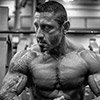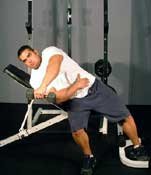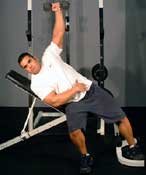It's quite an honor to be what is called an "advanced" bodybuilder. This status is bestowed only to the rare few who have had the discipline and patience to train regularly for a period of five years or more. Advanced bodybuilders are usually the best-built and most knowledgeable members of any gym or fitness facility.

However, there is also a flipside to this honorable station—most bodybuilders at this point cease to make meaningful improvements to their physiques ever again. Many theories/excuses are given to justify this: he or she has reached their genetic limit, they are happy with the way they look, they have tried everything possible, etc.
It is true that the longer you have been training, the harder it is to coax growth out of stubborn muscles that have had everything and the kitchen sink thrown at them over the years. Harder, to be sure, but impossible? Impossible is a word that does not belong in our vocabularies as athletes striving to be their absolute best!
Often what we think of as impossible is something that is already within our grasp, if only we thought of a creative solution to the problem. Ask yourself, is this exactly the way you wanted to look? I didn't think so. Don't worry. I'm not going to leave you hanging. All you really need to get growing again is the desire to do so.
Everything Else Is Really Secondary
I have been at this over thirteen years now, and the one thing I am happy to report is that I am still learning all the time. It is a challenge to try and find new techniques and strategies that will get my physique just a little bigger and better. It is also my privilege to share what I learn with you all as I discover it. If you look objectively at your progress over the past months or even years, are you satisfied? Do you look the same today as you did a year ago?
Are you using the same weights in the same exercises? If you can answer yes to these questions, then pay close attention. This article is speaking directly to you, the advanced trainer stuck in a rut. Let's get you out of that rut and growing again, shall we? We'll break it down into the basic three factors of bodybuilding; training, nutrition and supplementation, and rest and recovery.
Training
However you happen to be training now, it's safe to assume that your muscles have totally adapted to what you're doing. Hopefully you haven't been using the same exact exercises for each body part over and over again. This is an easy trap to fall into because we all have favorite exercises. For someone who loves to bench press, it's only natural that this exercise almost always forms the core of their chest workout. But because our bodies are so incredibly efficient at adapting to specific types of stress, the same exercises will only produce results for so long.
You may be able to use heavy weights and still get a great pump, but if your body has done it a thousand times before, odds are heavily against any new muscle growing. It's time to get radical and do only exercises that you never, ever do for a while. This should actually be very exciting, given the inevitable monotony of long-term training.
The Internet is a great place to get some ideas. Start surfing the net and you'll be amazed at how many useful websites there are for bodybuilders. I recently read of a new method of performing incline side laterals for delts from Charles Poliquin that resulted in a friend of mine experiencing the first soreness (and, most likely, growth) in that area in years.
There are dozens of exercises for each bodypart, and dozens of ways to perform various exercises.
Bill Pearl's legendary Keys to the Inner Universe literally lists thousands of exercises. Get creative and stimulate some muscle fibers you didn't even know you had with rarely-practiced movements like wide-grip dips, front squats, good mornings, power cleans, and standing military presses. Do not return to your usual routine of exercises for at least three months. You can bet this will shock your muscles into some wicked new growth, even if you haven't tickled the tape measure with expanded dimensions since Eddie Murphy was still on Saturday Night Live.
Nutrition and Supplementation
At the advanced level, nutrition and supplementation are more critical than ever. A beginner can eat a less than perfect diet and still manage to make gains, by virtue of how new the stress of weight training is to their body. Most of us got into lifting as teenagers, when "good nutrition" was a sugary bowl of cereal and milk for breakfast, a sandwich, chips, and soda for lunch, and a big, gooey bowl of macaroni and cheese or spaghetti for dinner. There were times when we would run around school campuses, malls and beaches without giving thought to food for half a day, when our gnawing hunger pangs would at last force us to seek out some sustenance.
After years of hard training, however, such transgressions will have a more profound negative impact. We all know that frequent meals, ideally eaten every two hours, are critical for maintaining a positive nitrogen balance as well as giving the body a constant supply of nutrients to fuel intense workouts and repair the subsequent damage inflicted to the muscles. But be honest with yourself—do you always eat every two hours, or do you sometimes let that stretch to three, four or even more?
And, are you sure to get at least 1.5 grams of protein per pound of bodyweight a day? If not, this is an easy problem to solve. You should already be preparing multiple meals at a time, such as several pounds of chicken breasts, rice, potatoes, and vegetables, packing them into Tupperware containers to eat throughout the day.
Food is the base of a great nutritional program, but it isn't enough for hard-training bodybuilders. Our training is one of the most stressful and demanding things you can put the human body through. Think about it—we literally lift tons of weight over the course of a workout, several times a week! To be sure you never have to go beyond two hours without eating, pack high-protein bars in the following places: your gym bag, your pouch/briefcase/pocketbook, your backpack if you're a student, the glove compartment of your car, and your desk at work. I would also recommend carrying shake bottles with protein powder, whey protein powder, or the contents of a meal-replacement powder packet already in them.
You can keep them anywhere, and simply add water for a powerful protein blast when you need it. Shakes are especially valuable for people whose jobs may keep them from being able to pause for solid meals for long periods at a time, or people who may have to travel a great deal of the day. It only takes a minute to mix up and drink a shake. With the great and convenient supplements we have available today, there's no reason you should ever be missing out on those critical nutrients you need to keep steadily feeding your hungry muscles.

Finally, in regards to supplements, be sure to take full advantage of the modern supplements on the market now. If you're an "old school" trainer who got into bodybuilding in the eighties or earlier, then your attitude towards supplements may be very cynical and jaded. A great deal of foul-tasting protein and weight gain shakes back then were full of fat and sugar, and produced little but bloating, gas and a fat gut. Aside from them, all that was offered were vitamins and amino tablets. Now, as we're in the 21st Century, science is at last providing us with products that really work.
You can use creatine monohydrate for volumizing muscle cells, boosting your strength, and gaining solid weight, L-glutamine for faster recovery and boosting the immune system, whey protein for a low-calorie protein source that is actually absorbed more completely by the human body than any food, and a plethora of fat-burning products like Hydroxycut or any of the ephedrine/caffeine stacks that will literally help you strip away ugly body fat.
Of course, there are now GH-releasers, and even effervescent creatine. At the advanced level of training, it makes sense to try new products as they are introduced on the market. Any of them could easily help you put on a little more muscle or lose a little more fat than you would with diet and exercise alone. Even if a product only makes a five percent difference in the end, that's five percent that you never would have had otherwise!
Rest and Recovery
It's 1999, and we all want the good things in life. For many of us, that means a lifestyle of long work hours and running endless errands. Eight hours of sleep is something many people of our generation haven't had consistently in years. Analyze your schedule and see if there are ways you could be making better use of your time, consolidating activities to make time for the sleep your body needs to recover and grow.
If you can take naps during the day, no matter how brief, by all means do so. Use weekends or vacations to try and catch up on sleep. All the great training and nutrition in the world can easily be sabotaged by lack of adequate sleep. You don't have to feel like a lazy bum either. Rather, you should feel like you're short-changing yourself if you don't get enough rest, because from a bodybuilding standpoint, that's exactly what you're doing.
Training body parts too often is another hidden roadblock that will stall you out and put you in a rut. Many people are convinced that a body part must be trained twice a week or it will begin to atrophy. An entire generation of bodybuilders are now proving this to be totally incorrect. The current trend is to hit a body part hard just once a week, then leave it alone to allow time for repair and super compensation. So many body parts overlap in training that there is no need to fear that any muscle will start to atrophy.
Deadlifts are for back, but they certainly involve the legs and biceps a great deal as well.
Chest training will also hit the front delts and triceps, shoulder training hits the traps and triceps, and back training actually trains the biceps and rear delts harder for some people than actual isolation training. Since Skip LaCour, natural Team Universe Champion, began writing about the once-a-week body part split several years ago, it has skyrocketed in popularity, especially among drug-free trainers. It's a perfect way to annihilate each body part, giving it all your focus and energy, then allowing it to grow rather than whacking it again while it's still trying to recover.
Here's A Sample Split
- Sunday: Rest
- Monday: Chest and Biceps
- Tuesday: Legs
- Wednesday: Rest
- Thursday: Back and Triceps
- Friday: Rest
- Saturday: Shoulders, Abs, and Calves
Conclusion
If you can't even remember the last time you gained any muscle or improved, it's time you got down to business and made the changes necessary to get back in the game. Whether you've been training for five, ten, or even 20 years, there is always room for improvement. Very, very few people have ever hit their "genetic limit." The odds are that you haven't, either.
If you're sick of being stuck in a rut, get out today and get working on a new and better you. The name of our sport is bodybuilding, not body maintaining. That means that there's no reason why you should ever stop growing. See you in the gym with a new plan and a new attitude, veterans!
Reprinted with permission from eMuscleMag.
You may contact Ron Harris at www.ronharrismuscle.com.



